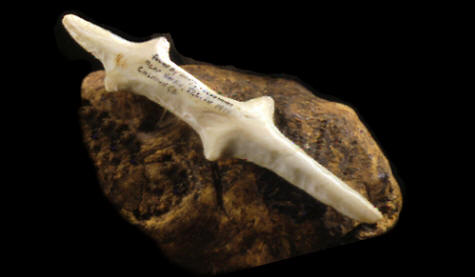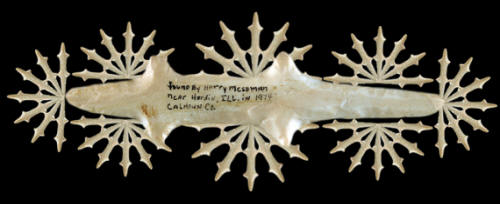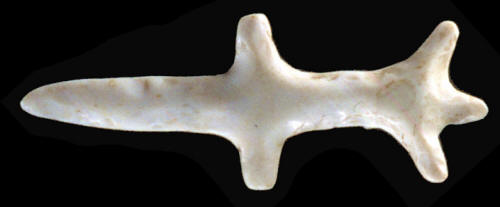|
||
|
||
|
"The majority of these polished (lizard) effigies have been made from white or cream-buff flint that is found in this area (Missouri & Illinois) and usually in length from about three to four inches."----1967, by B. W. Stevens, "A Polished Lizard," Central States Archaeological Journal, vol. 14, no. 2, p. 57. "Their (polished lizards) center of their distribution seems to be central and southern Illinois, as well as eastern Missouri."----2005, by ?, "Lizard, Bird and Animal flint Effigies," Prehistoric American, vol. 39, no. 4, p. 3. "In several instances (in Hohokam culture) there is a curious ambiguity in the rendering of lizard forms. Certain examples from the Painted Rocks area and the Flagstaff region could be interpreted as human as readily as lizard representations."----1978, by E. Wesley Jernigan, "The Aymara," Jewelery of the prehistoric southwest, p. 57. "With the lizard theme (in Hohhokam culture), variations are almost as numerous as the pendants themselves.--- The manner in which a number of Classic period lizards resemble the needle pendant in shell supports the notion that the latter were pendants rather than utilitarian items"----1978, by E. Wesley Jernigan, "Jewelry Of The Prehistoric Southwest," p. 57. "(In a Pomo myth) Lizard succeeded in making human beings, all except their hands"----1933, by S. A. Barrett, "Pomo Myths," p. 81. "Amongst especially the Western Arunta (in central Australia) the medicine man in addition to the Atnongara stones (which are magic stones contained within the medicine man for as long as he retains his healing powers) is supposed to have a particular kind of lizard distributed through his body, which endows him with great suctorial power, such as the natives attribute to the lizard itself."---------1968, by Baldwin Spencer & F. J. Gillen, "The Native Tribes of Central Australia," pp. 525 & 531. "Ghosts, which often appeared in the guise of lizards, caimans, jaguars, deer, or deer-footed men, were the souls of wicked persons or of people who had not been buried according to prescribed rites."---------1946, by Alfred Metraux, "The Purf-Coroado Linguistic Family," Handbook of South American Indians, p. 529. "Freshly killed lizards are applied to injured limbs to reduce the swelling and draw out bad blood (The Aymara of Peru & Bolivia)---."----1946, by Harry Tschopik, Jr., "The Aymara," Handbook of South American Indians, p. 569.
Polished chert lizard effigies are one of several prehistorically made artifacts that have no known function. Archaeologists writing about them in the past have referred to them as problematical objects. Although their form is that of a lizard, beyond that, very little is known. Terms that might be used to label them, if compared to objects from historic tribes, might be emblems, fetishes, insignia, luck stones, medicine stones, symbols or talismans. But with no real opportunity of ever speaking with a living people who made them, there is hardly any chance of ever knowing what polished lizards were used for. |
||
|
All the polished lizards in this article are believed to have been surface collected in cultivated fields in Illinois and Missouri. More polished chert lizard effigies have been reported from southern Illinois than anywhere else. In a 2005 issue of "Prehistoric American" there are approximately 30 polished chert lizards and one copper lizard effigy illustrated. Twenty four of them are reported to have been found in Illinois, three from Missouri, two from Indiana and one from Kentucky. |
||
|
||
|
Polished chert lizards are rare objects and, as would be expected, very little is known about them from excavated sites. One woodland period copper lizard is reported to have been found in Crib mound in Spencer County, Indiana. Estimated dates for these objects range from the Late Archaic to the Late Middle Woodland period. Sometime between 800 B.C. to A.D. 400, 2,800 to 1,600 years ago. |
||
|
||
|
The majority of all chert lizard effigies were made from white Burlington chert. Although one made from Kaolin and two made from Cobden chert have also been reported. In addition, one lizard made of copper has also been reported from Indiana. |
||
| CONTINUE ON TO PAGE TWO | ||
|
"REFERENCES"
1912, Hodge, Frederick Webb,
"Problematical Objects," Handbook of American Indians North of Mexico,
pp. 307-308. |
||





